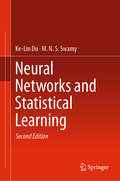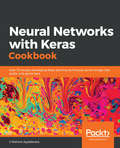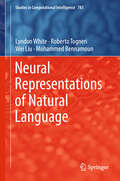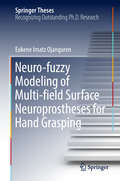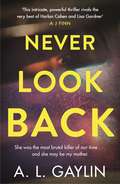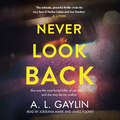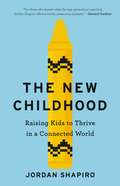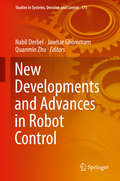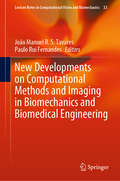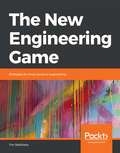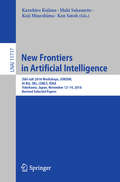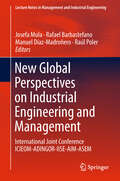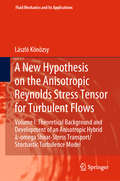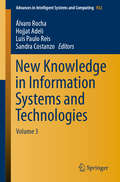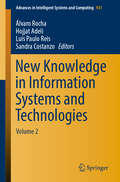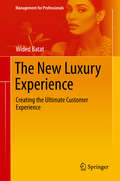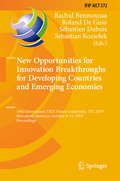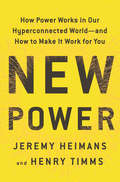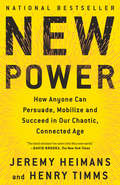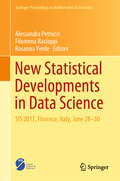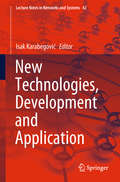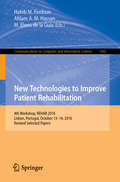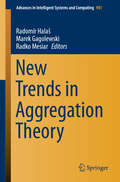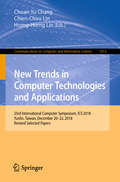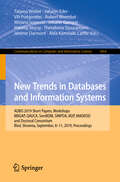- Table View
- List View
Neural Networks and Statistical Learning
by Ke-Lin Du M. N. SwamyThis book provides a broad yet detailed introduction to neural networks and machine learning in a statistical framework. A single, comprehensive resource for study and further research, it explores the major popular neural network models and statistical learning approaches with examples and exercises and allows readers to gain a practical working understanding of the content. This updated new edition presents recently published results and includes six new chapters that correspond to the recent advances in computational learning theory, sparse coding, deep learning, big data and cloud computing.Each chapter features state-of-the-art descriptions and significant research findings. The topics covered include:• multilayer perceptron;• the Hopfield network;• associative memory models;• clustering models and algorithms;• t he radial basis function network;• recurrent neural networks;• nonnegative matrix factorization;• independent component analysis;•probabilistic and Bayesian networks; and• fuzzy sets and logic.Focusing on the prominent accomplishments and their practical aspects, this book provides academic and technical staff, as well as graduate students and researchers with a solid foundation and comprehensive reference on the fields of neural networks, pattern recognition, signal processing, and machine learning.
Neural Networks with Keras Cookbook: Over 70 recipes leveraging deep learning techniques across image, text, audio, and game bots
by V Kishore AyyadevaraImplement neural network architectures by building them from scratch for multiple real-world applications.Key FeaturesFrom scratch, build multiple neural network architectures such as CNN, RNN, LSTM in KerasDiscover tips and tricks for designing a robust neural network to solve real-world problemsGraduate from understanding the working details of neural networks and master the art of fine-tuning themBook DescriptionThis book will take you from the basics of neural networks to advanced implementations of architectures using a recipe-based approach.We will learn about how neural networks work and the impact of various hyper parameters on a network's accuracy along with leveraging neural networks for structured and unstructured data.Later, we will learn how to classify and detect objects in images. We will also learn to use transfer learning for multiple applications, including a self-driving car using Convolutional Neural Networks.We will generate images while leveraging GANs and also by performing image encoding. Additionally, we will perform text analysis using word vector based techniques. Later, we will use Recurrent Neural Networks and LSTM to implement chatbot and Machine Translation systems.Finally, you will learn about transcribing images, audio, and generating captions and also use Deep Q-learning to build an agent that plays Space Invaders game.By the end of this book, you will have developed the skills to choose and customize multiple neural network architectures for various deep learning problems you might encounter.What you will learnBuild multiple advanced neural network architectures from scratchExplore transfer learning to perform object detection and classificationBuild self-driving car applications using instance and semantic segmentationUnderstand data encoding for image, text and recommender systemsImplement text analysis using sequence-to-sequence learningLeverage a combination of CNN and RNN to perform end-to-end learningBuild agents to play games using deep Q-learningWho this book is forThis intermediate-level book targets beginners and intermediate-level machine learning practitioners and data scientists who have just started their journey with neural networks. This book is for those who are looking for resources to help them navigate through the various neural network architectures; you'll build multiple architectures, with concomitant case studies ordered by the complexity of the problem. A basic understanding of Python programming and a familiarity with basic machine learning are all you need to get started with this book.
Neural Representations of Natural Language (Studies in Computational Intelligence #783)
by Lyndon White Roberto Togneri Wei Liu Mohammed BennamounThis book offers an introduction to modern natural language processing using machine learning, focusing on how neural networks create a machine interpretable representation of the meaning of natural language. Language is crucially linked to ideas – as Webster’s 1923 “English Composition and Literature” puts it: “A sentence is a group of words expressing a complete thought”. Thus the representation of sentences and the words that make them up is vital in advancing artificial intelligence and other “smart” systems currently being developed. Providing an overview of the research in the area, from Bengio et al.’s seminal work on a “Neural Probabilistic Language Model” in 2003, to the latest techniques, this book enables readers to gain an understanding of how the techniques are related and what is best for their purposes. As well as a introduction to neural networks in general and recurrent neural networks in particular, this book details the methods used for representing words, senses of words, and larger structures such as sentences or documents. The book highlights practical implementations and discusses many aspects that are often overlooked or misunderstood. The book includes thorough instruction on challenging areas such as hierarchical softmax and negative sampling, to ensure the reader fully and easily understands the details of how the algorithms function. Combining practical aspects with a more traditional review of the literature, it is directly applicable to a broad readership. It is an invaluable introduction for early graduate students working in natural language processing; a trustworthy guide for industry developers wishing to make use of recent innovations; and a sturdy bridge for researchers already familiar with linguistics or machine learning wishing to understand the other.
Neuro-fuzzy Modeling of Multi-field Surface Neuroprostheses for Hand Grasping (Springer Theses)
by Eukene Imatz OjangurenThis thesis presents a novel neuro-fuzzy modeling approach for grasp neuroprostheses. At first, it offers a detailed study of discomfort due to the application of Functional Electrical Stimulation to the upper limb. Then, it discusses briefly previous methods to model hand movements induced by FES with the purpose of introducing the new modeling approach based on intelligent systems. This approach is thoroughly described in the book, together with the proposed application to induce hand and finger movements by means of a surface FES system based on multi-field electrodes. The validation tests, carried out on both healthy and neurologically impaired subjects, demonstrate the efficacy of the proposed modeling method. All in all, the book proposes an innovative system based on fuzzy neural networks that is expected to improve the design and validation of advanced control systems for non-invasive grasp neuroprostheses.
Never Look Back: She was the most brutal serial killer of our time. And she may have been my mother.
by A.L. Gaylin'Aflame with tension. An intricate, powerful thriller - rivals the very best of Harlan Coben and Lisa Gardner' AJ Finn, author of THE WOMAN IN THE WINDOW*****************She was the most brutal killer of our time. And she may have been my mother...When website columnist Robin Diamond is contacted by true crime podcast producer Quentin Garrison, she assumes it's a business matter. It's not. Quentin's podcast, Closure, focuses on a series of murders in the 1970s, committed by teen couple April Cooper and Gabriel LeRoy. It seems that Quentin has reason to believe Robin's own mother may be intimately connected with the killings.Robin thinks Quentin's claim is absurd. But is it? The more she researches the Cooper/LeRoy murders herself, the more disturbed she becomes by what she finds. Living just a few blocks from her, Robin's beloved parents are the one absolute she's always been able to rely upon, especially now amid rising doubts about her husband and frequent threats from internet trolls. Robin knows her mother better than anyone.But then her parents are brutally attacked, and Robin realises she doesn't know the truth at all...*****************'Completely absorbing with a knock-out twist' Harlan Coben'Gaylin is an expert at acute emotional observation combined with seamless plotting' Alex Marwood'AL Gaylin is at the top of her game, crafting exhilarating and audacious crime novels that are both rich in character and rivetingly told. They are, quite simply, not to be missed' Megan Abbott'AL Gaylin is a storyteller guaranteed to keep you up at night' Laura Lippman'AL Gaylin is a great storyteller' Mark Billingham'A fiendishly well-told thriller that deepens its grip the faster you read - I loved it' Louise CandlishIf you love Serial, S-Town, Clare Mackintosh, Cara Hunter, KL Slater or Lisa Jewell, you will be utterly gripped by this psychological thriller with a twist you'll never see coming...
Never Look Back: She was the most brutal serial killer of our time. And she may have been my mother.
by A.L. GaylinShe was the most brutal killer of our time. And she may have been my mother...When website columnist Robin Diamond is contacted by true crime podcast producer Quentin Garrison, she assumes it's a business matter. It's not. Quentin's podcast, Closure, focuses on a series of murders in the 1970s, committed by teen couple April Cooper and Gabriel LeRoy. It seems that Quentin has reason to believe Robin's own mother may be intimately connected with the killings.Robin thinks Quentin's claim is absurd. But is it? The more she researches the Cooper/LeRoy murders herself, the more disturbed she becomes by what she finds. Living just a few blocks from her, Robin's beloved parents are the one absolute she's always been able to rely upon, especially now amid rising doubts about her husband and frequent threats from internet trolls. Robin knows her mother better than anyone.But then her parents are brutally attacked, and Robin realises she doesn't know the truth at all...
The New Childhood: Raising Kids to Thrive in a Connected World
by Jordan ShapiroA provocative look at the new, digital landscape of childhood and how to navigate it.In The New Childhood, Jordan Shapiro provides a hopeful counterpoint to the fearful hand-wringing that has come to define our narrative around children and technology. Drawing on groundbreaking research in economics, psychology, philosophy, and education, The New Childhood shows how technology is guiding humanity toward a bright future in which our children will be able to create new, better models of global citizenship, connection, and community.Shapiro offers concrete, practical advice on how to parent and educate children effectively in a connected world, and provides tools and techniques for using technology to engage with kids and help them learn and grow. He compares this moment in time to other great technological revolutions in humanity's past and presents entertaining micro-histories of cultural fixtures: the sandbox, finger painting, the family dinner, and more. But most importantly, The New Childhood paints a timely, inspiring and positive picture of today's children, recognizing that they are poised to create a progressive, diverse, meaningful, and hyper-connected world that today's adults can only barely imagine.
New Developments and Advances in Robot Control (Studies in Systems, Decision and Control #175)
by Nabil Derbel Jawhar Ghommam Quanmin ZhuThis book highlights relevant studies and applications in the area of robotics, which reflect the latest research, from interdisciplinary theoretical studies and computational algorithm development, to representative applications. It presents chapters on advanced control, such as fuzzy, neural, backstepping, sliding mode, adaptive, predictive, diagnosis and fault tolerant control etc. and addresses topics including cloud robotics, cable-driven robots, two-wheeled robots, mobile robots, swarm robots, hybrid vehicle, and drones. Each chapter employs a uniform structure: background, motivation, quantitative development (equations), case studies/illustration/tutorial (simulations, experiences, curves, tables, etc.), allowing readers to easily tailor the techniques to their own applications.
New Developments on Computational Methods and Imaging in Biomechanics and Biomedical Engineering (Lecture Notes in Computational Vision and Biomechanics #999)
by Paulo Rui Fernandes João Manuel R. S. TavaresThis book gathers selected, extended and revised contributions to the 15th International Symposium on Computer Methods in Biomechanics and Biomedical Engineering (CMBBE2018), and the 3rd Conference on Imaging and Visualization, which took place on 26-29 March, 2018, in Lisbon, Portugal. The respective chapters highlight cutting-edge methods, e.g. new algorithms, image analysis techniques, and multibody modeling methods; and new findings obtained by applying them in biological and/or medical contexts. Original numerical studies, Monte Carlo simulations, FEM analyses and reaction-diffusion models are described in detail, together with intriguing new applications. The book offers a timely source of information for biologists, engineers, applied mathematicians and clinical researchers working on multidisciplinary projects, and is also intended to foster closer collaboration between these groups.
The New Engineering Game: Strategies for smart product engineering
by Tim WeilkiensAdapt to a world of digitalization and get ready to become a successful player in the new engineering game Key Features • Discover what the fourth industrial revolution is all about • Explore the new engineering game through the context of globalization, craftsmanship, and interdisciplinary engineering • Develop strategies to improve the engineering of products with functional architecture, lean systems engineering, and more Book Description Organizations today face an increasingly complex and dynamic environment, whatever their market. This change requires new systems that are built on the foundation of a new kind of engineering and thinking. The New Engineering Game closes the gap between high-level reflections about digitalization and daily engineering methods and tools. The book begins by describing the first three industrial revolutions and their consequences, and by predicting the fourth industrial revolution. Considering the fourth industrial revolution, it explains the need for a new kind of engineering. The later chapters of the book provide valuable principles, patterns, methods, and tools that engineering organizations can learn and use to succeed on the playfield of digitalization. By the end of the book, you'll have all the information you need to understand the various concepts to take your first steps towards the world of digitalization. What you will learn • Deal with the challenges of Conway's Law • Explore domains from different viewpoints with the Cynefin framework • Use the Business Model Canvas (BMC) to view your business model in one chart • Use the Business Model Navigator (BMN) to elaborate your business model • Get an overview of REThink 4.0 • Discover how to apply the principles of the Agile Manifesto for Software Development in your projects Who this book is for This book is for those of you who want to want to gear up for the ever-evolving and dynamic environment that has come into play with digitalization. Anyone who wants to create industry-grade applications using smart product engineering techniques will find this book useful. To grasp all that has been explained in this book, all you need is a knowledge-seeking attitude.
New Frontiers in Artificial Intelligence: JSAI-isAI 2018 Workshops, JURISIN, AI-Biz, SKL, LENLS, IDAA, Yokohama, Japan, November 12–14, 2018, Revised Selected Papers (Lecture Notes in Computer Science #11717)
by Kazuhiro Kojima Maki Sakamoto Koji Mineshima Ken SatohThis book constitutes extended, revised, and selected papers from the 10th International Symposium of Artificial Intelligence supported by the Japanese Society for Artificial Intelligence, JSAI-isAI 2018. It was held in November 2018 in Yokohama, Japan. The 28 paper full papers and 5 short papers were carefully selected from 97 submissions. The papers selected cover topics in Artificial Intelligence, such as AI and law, business intelligence, human intelligence, logic and engineering, and data analytics and applications.
New Global Perspectives on Industrial Engineering and Management: International Joint Conference ICIEOM-ADINGOR-IISE-AIM-ASEM (Lecture Notes In Management And Industrial Engineering Ser.)
by Raúl Poler Manuel Díaz-Madroñero Rafael Barbastefano Josefa MulaThis book presents the proceedings of the 3rd International Joint Conference – ICIEOM-ADINGOR-IISE-AIM-ASEM (IJC2017) “XXIII International Conference on Industrial Engineering and Operations Management”, “International ADINGOR Conference 2017”, “International IISE Conference 2017”, “International AIM Conference 2017” and “International ASEM Conference 2017”, which took place at UPV (Universitat Politècnica de València) from July 6th to 7th, 2017. This joint conference is the result of an agreement between ABEPRO (Associação Brasileira de Engenharia de Produção), ADINGOR (Asociación para el Desarrollo de la Ingeniería de Organización), IISE (Institute of Industrial and Systems Engineers), AIM (European Academy for Industrial Management) and ASEM (American Society for Engineering Management).Consisting of papers on new global perspectives on industrial engineering and management, the book offers an interdisciplinary view of industrial engineering and management. The topics covered include: strategy and entrepreneurship, quality and product management, modelling and simulation, knowledge and project management, logistics, as well as production, information and service systems.
A New Hypothesis on the Anisotropic Reynolds Stress Tensor for Turbulent Flows: Volume I: Theoretical Background and Development of an Anisotropic Hybrid k-omega Shear-Stress Transport/Stochastic Turbulence Model (Fluid Mechanics and Its Applications #120)
by László KönözsyThis book gives a mathematical insight--including intermediate derivation steps--into engineering physics and turbulence modeling related to an anisotropic modification to the Boussinesq hypothesis (deformation theory) coupled with the similarity theory of velocity fluctuations. Through mathematical derivations and their explanations, the reader will be able to understand new theoretical concepts quickly, including how to put a new hypothesis on the anisotropic Reynolds stress tensor into engineering practice. The anisotropic modification to the eddy viscosity hypothesis is in the center of research interest, however, the unification of the deformation theory and the anisotropic similarity theory of turbulent velocity fluctuations is still missing from the literature. This book brings a mathematically challenging subject closer to graduate students and researchers who are developing the next generation of anisotropic turbulence models. Indispensable for graduate students, researchers and scientists in fluid mechanics and mechanical engineering.
New Knowledge in Information Systems and Technologies: Volume 3 (Advances in Intelligent Systems and Computing #932)
by Álvaro Rocha Hojjat Adeli Luís Paulo Reis Sandra CostanzoThis book includes a selection of articles from The 2019 World Conference on Information Systems and Technologies (WorldCIST’19), held from April 16 to 19, at La Toja, Spain. WorldCIST is a global forum for researchers and practitioners to present and discuss recent results and innovations, current trends, professional experiences and challenges in modern information systems and technologies research, together with their technological development and applications. The book covers a number of topics, including A) Information and Knowledge Management; B) Organizational Models and Information Systems; C) Software and Systems Modeling; D) Software Systems, Architectures, Applications and Tools; E) Multimedia Systems and Applications; F) Computer Networks, Mobility and Pervasive Systems; G) Intelligent and Decision Support Systems; H) Big Data Analytics and Applications; I) Human–Computer Interaction; J) Ethics, Computers & Security; K) Health Informatics; L) Information Technologies in Education; M) Information Technologies in Radiocommunications; and N) Technologies for Biomedical Applications.
New Knowledge in Information Systems and Technologies: Volume 2 (Advances in Intelligent Systems and Computing #931)
by Hojjat Adeli Álvaro Rocha Luís Paulo Reis Sandra CostanzoThis book includes a selection of articles from The 2019 World Conference on Information Systems and Technologies (WorldCIST’19), held from April 16 to 19, at La Toja, Spain.WorldCIST is a global forum for researchers and practitioners to present and discuss recent results and innovations, current trends, professional experiences and challenges in modern information systems and technologies research, together with their technological development and applications.The book covers a number of topics, including A) Information and Knowledge Management; B) Organizational Models and Information Systems; C) Software and Systems Modeling; D) Software Systems, Architectures, Applications and Tools; E) Multimedia Systems and Applications; F) Computer Networks, Mobility and Pervasive Systems; G) Intelligent and Decision Support Systems; H) Big Data Analytics and Applications; I) Human–Computer Interaction; J) Ethics, Computers & Security; K) Health Informatics; L) Information Technologies in Education; M) Information Technologies in Radiocommunications; and N) Technologies for Biomedical Applications.
The New Luxury Experience: Creating the Ultimate Customer Experience (Management for Professionals)
by Wided BatatThis professional book introduces marketing and luxury brand professionals to a new definition of luxury and the art of designing the ultimate luxury experience in both the physical space (e.g., in-store, hotel, restaurant) and the digital space (e.g., social media, website, e-commerce). Specifically, it offers an overview of customer experience issues and explores big five experiential strategies that can be applied by luxury houses in order to provide the best luxury experience to their customers. Themes such as quality of customer luxury experience, immersion and co-production/co-creation in luxury, creation and management, digital and immersive marketing, and innovative market research are also examined. How do consumers define luxury? Is there one luxury or several “luxuries”? What kind of luxury experiences consumers want to live? How can luxury houses design the ultimate luxury experience? More than in any other sector, luxury consumption is a response to a search for emotions, pleasure, uniqueness, consideration and greatest services. The luxury consumer wants to live luxury experiences – not just buy luxury products or services. In this way, this book presents the luxury consumption experience as a combination of symbolic meaning, subconscious processes and nonverbal cues and characterized by fantasies, feelings and fun. Featuring case studies and interviews from international luxury sectors and brand managers such as Burberry, Dior, Porsche, Breitling, St. Regis Hotels & Resorts, and Louis Vuitton, among others, this book offers both a research and management perspective on luxury experience to professionals in the luxury sector (e.g., CEOs, brand managers, marketing and communication professionals), as well as marketing professors, students, and people eager to learn more about how to design the ultimate luxury experience. Praise for The New Luxury Experience “This book provides a holistic perspective on marketing of luxury brands, offering both useful practical advice as well as illustrating important cases.” -- Ravi Dhar, Director, Yale Center for Customer Insights, Yale University “Wided Batat’s book offers a fresh, insightful and comprehensive analysis of the concept of the consumer’s experience with luxury whatever that may be. The Five experiential luxury strategies proposed by Wided highlight that luxury management should go above and beyond the design and branding of luxury goods and services. I also commend the consideration given to the younger generations’ approach to luxury and to corporate social responsibility aspects. Luxury marketers should find this book very useful indeed.” -- Francesca Dall’Olmo Riley, Professor of Brand Management, Kingston Business School, UK
New Opportunities for Innovation Breakthroughs for Developing Countries and Emerging Economies: 19th International TRIZ Future Conference, TFC 2019, Marrakesh, Morocco, October 9–11, 2019, Proceedings (IFIP Advances in Information and Communication Technology #572)
by Roland De Guio Sebastian Koziołek Rachid Benmoussa Sébastien DuboisThis book constitutes the refereed proceedings of the 19th International TRIZ Future Conference on Automated Invention for Smart Industries, held in Marrakesh, Morocco, in October 2019 and sponsored by IFIP WG 5.4. The 41 full papers presented were carefully reviewed and selected from 72 submissions. They are organized in seven thematic sections: TRIZ improvement: theory, methods and tools; TRIZ and other innovation approaches; TRIZ applications in technical design; TRIZ applications in eco design; TRIZ applications in software engineering; TRIZ applications in specific disciplinary fields; and TRIZ in teaching.
New Power: How Power Works in Our Hyperconnected World--and How to Make It Work for You
by Jeremy Heimans Henry TimmsFrom two influential and visionary thinkers comes a big idea that is changing the way movements catch fire and ideas spread in our highly connected world.For the vast majority of human history, power has been held by the few. "Old power" is closed, inaccessible, and leader-driven. Once gained, it is jealously guarded, and the powerful spend it carefully, like currency. But the technological revolution of the past two decades has made possible a new form of power, one that operates differently, like a current. "New power" is made by many; it is open, participatory, often leaderless, and peer-driven. Like water or electricity, it is most forceful when it surges. The goal with new power is not to hoard it, but to channel it. New power is behind the rise of participatory communities like Facebook and YouTube, sharing services like Uber and Airbnb, and rapid-fire social movements like Brexit and #BlackLivesMatter. It explains the unlikely success of Barack Obama's 2008 campaign and the unlikelier victory of Donald Trump in 2016. And it gives ISIS its power to propagate its brand and distribute its violence. Even old power institutions like the Papacy, NASA, and LEGO have tapped into the strength of the crowd to stage improbable reinventions. In New Power, the business leaders/social visionaries Jeremy Heimans and Henry Timms provide the tools for using new power to successfully spread an idea or lead a movement in the twenty-first century. Drawing on examples from business, politics, and social justice, they explain the new world we live in--a world where connectivity has made change shocking and swift and a world in which everyone expects to participate.
New Power: How Power Works in Our Hyperconnected World--and How to Make It Work for You
by Jeremy Heimans Henry TimmsIn this indispensable guide to navigating the twenty-first century, two visionary thinkers reveal the unexpected ways power is changing--and how "new power" is reshaping politics, business, and life.Why do some leap ahead while others fall behind in our chaotic, connected age? In New Power, Jeremy Heimans and Henry Timms confront the biggest stories of our time--the rise of mega-platforms like Facebook and Uber; the out-of-nowhere victories of Obama and Trump; the unexpected emergence of movements like #MeToo--and reveal what's really behind them: the rise of "new power."For most of human history, the rules of power were clear: power was something to be seized and then jealously guarded. This "old power" was out of reach for the vast majority of people. But our ubiquitous connectivity makes possible a different kind of power. "New power" is made by many. It is open, participatory, and peer-driven. It works like a current, not a currency--and it is most forceful when it surges. The battle between old and new power is determining who governs us, how we work, and even how we think and feel. New Power shines fresh light on the cultural phenomena of our day, from #BlackLivesMatter to the Ice Bucket Challenge to Airbnb, uncovering the new power forces that made them huge. Drawing on examples from business, activism, and pop culture, as well as the study of organizations like Lego, NASA, Reddit, and TED, Heimans and Timms explain how to build new power and channel it successfully. They also explore the dark side of these forces: the way ISIS has co-opted new power to monstrous ends, and the rise of the alt-right's "intensity machine."In an era increasingly shaped by new power, this groundbreaking book offers us a new way to understand the world--and our role in it.
New Statistical Developments in Data Science: SIS 2017, Florence, Italy, June 28-30 (Springer Proceedings in Mathematics & Statistics #288)
by Alessandra Petrucci Filomena Racioppi Rosanna VerdeThis volume collects the extended versions of papers presented at the SIS Conference “Statistics and Data Science: new challenges, new generations”, held in Florence, Italy on June 28-30, 2017. Highlighting the central role of statistics and data analysis methods in the era of Data Science, the contributions offer an essential overview of the latest developments in various areas of statistics research. The 35 contributions have been divided into six parts, each of which focuses on a core area contributing to “Data Science”. The book covers topics including strong statistical methodologies, Bayesian approaches, applications in population and social studies, studies in economics and finance, techniques of sample design and mathematical statistics. Though the book is mainly intended for researchers interested in the latest frontiers of Statistics and Data Analysis, it also offers valuable supplementary material for students of the disciplines dealt with here. Lastly, it will help Statisticians and Data Scientists recognize their counterparts’ fundamental role.
New Technologies, Development and Application (Lecture Notes in Networks and Systems #42)
by Isak KarabegovićThe papers included in this book were presented at the International Conference “New Technologies, Development and Application,” which was held at the Academy of Sciences and Arts of Bosnia and Herzegovina in Sarajevo, Bosnia and Herzegovina on 28th–30th June 2018. The book covers a wide range of technologies and technical disciplines including complex systems such as: Robotics, Mechatronics Systems, Automation, Manufacturing, Cyber-Physical Systems, Autonomous Systems, Sensors, Networks, Control Systems, Energy Systems, Automotive Systems, Biological Systems, Vehicular Networking and Connected Vehicles, Effectiveness and Logistics Systems, Smart Grids, Nonlinear Systems, Power Systems, Social Systems, and Economic Systems.
New Technologies to Improve Patient Rehabilitation: 4th Workshop, REHAB 2016, Lisbon, Portugal, October 13-14, 2016, Revised Selected Papers (Communications in Computer and Information Science #1002)
by Habib M. Fardoun Ahlam A. Hassan M. Elena de la GuíaThis book constitutes the thoroughly refereed proceedings of the 4th International Workshop on ICTs for Improving Patients Rehabilitation Research Techniques, REHAB 2016, held in Lisbon, Portugal, in October 2016.The 10 revised full papers presented were carefully reviewed and selected from 33 submissions. The papers explore how technology can contribute toward smarter and effective rehabilitation methods.
New Trends in Aggregation Theory (Advances in Intelligent Systems and Computing #981)
by Radomír Halaš Marek Gagolewski Radko MesiarThis book collects the contributions presented at AGOP 2019, the 10th International Summer School on Aggregation Operators, which took place in Olomouc (Czech Republic) in July 2019. It includes contributions on topics ranging from the theory and foundations of aggregation functions to their various applications. Aggregation functions have numerous applications, including, but not limited to, data fusion, statistics, image processing, and decision-making. They are usually defined as those functions that are monotone with respect to each input and that satisfy various natural boundary conditions. In particular settings, these conditions might be relaxed or otherwise customized according to the user’s needs. Noteworthy classes of aggregation functions include means, t-norms and t-conorms, uninorms and nullnorms, copulas and fuzzy integrals (e.g., the Choquet and Sugeno integrals). This book provides a valuable overview of recent research trends in this area.
New Trends in Computer Technologies and Applications: 23rd International Computer Symposium, ICS 2018, Yunlin, Taiwan, December 20–22, 2018, Revised Selected Papers (Communications in Computer and Information Science #1013)
by Chuan-Yu Chang Chien-Chou Lin Horng-Horng LinThe present book includes extended and revised versions of papers presented during the 2018 International Computer Symposium (ICS 2018), held in Yunlin, Republic of China (Taiwan), on December 20-22, 2018.The 86 papers presented were carefully reviewed and selected from 263 submissions from 11 countries. The variety of the topics include machine learning, sensor devices and platforms, sensor networks, robotics, embedded systems, networks, operating systems, software system structures, database design and models, multimedia and multimodal retrieval, object detection, image processing, image compression, mobile and wireless security.
New Trends in Databases and Information Systems: ADBIS 2019 Short Papers, Workshops BBIGAP, QAUCA, SemBDM, SIMPDA, M2P, MADEISD, and Doctoral Consortium, Bled, Slovenia, September 8–11, 2019, Proceedings (Communications in Computer and Information Science #1064)
by Tatjana Welzer Johann Eder Vili Podgorelec Robert Wrembel Mirjana Ivanović Johann Gamper Mikoƚaj Morzy Theodoros Tzouramanis Jérôme Darmont Aida Kamišalić LatifićThis book constitutes the thoroughly refereed short papers, workshops and doctoral consortium papers of the 23rd European Conference on Advances in Databases and Information Systems, ADBIS 2019, held in Bled, Slovenia, in September 2019.The 19 short research papers and the 5 doctoral consortium papers were carefully reviewed and selected from 103 submissions, and the 31 workshop papers were selected out of 67 submitted papers. The papers are organized in the following sections: Short Papers; Workshops Papers; Doctoral Consortium Papers; and cover a wide spectrum of topics related to database and information systems technologies for advanced applications.
